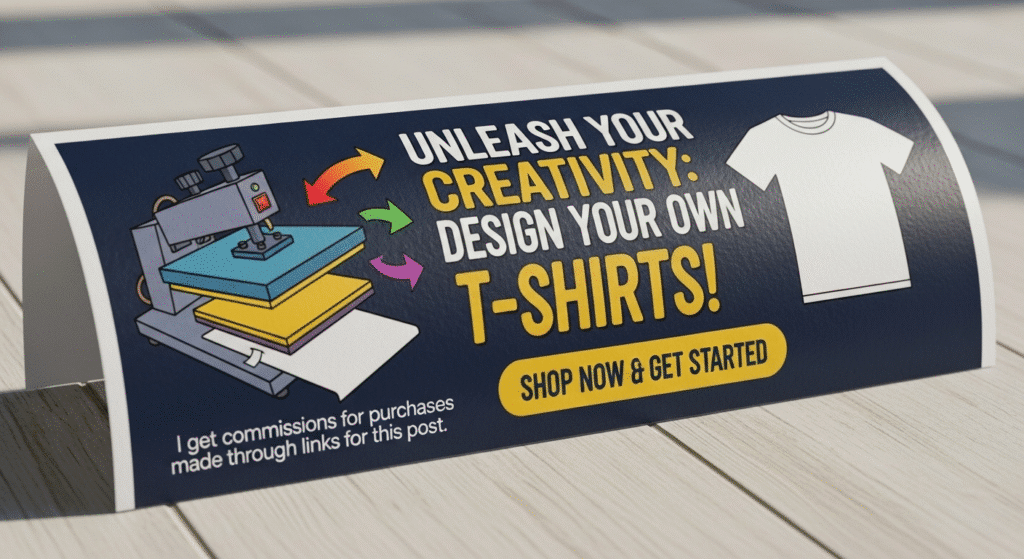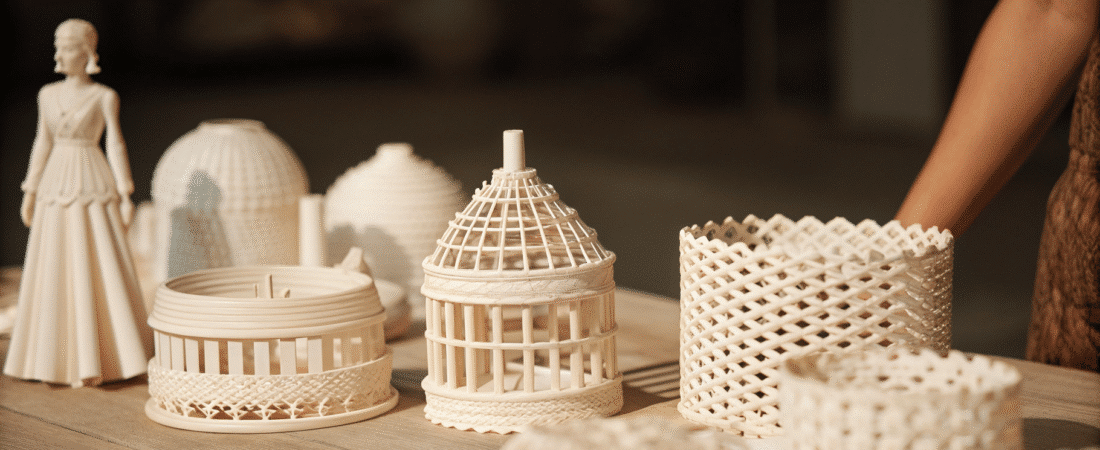Let your imagination run wild as you discover the therapeutic world of three-dimensional crafting. While flat arts and crafts have their charm, there’s something uniquely satisfying about creating artwork you can touch, rotate, and admire from every angle. As adults increasingly seek creative outlets that provide both stress relief and impressive results, 3D crafts have emerged as a perfect solution for modern life.
Unlike traditional two-dimensional art forms, dimensional crafting engages multiple senses and offers a complete break from screen-based activities. Whether you’re looking to decorate your house, create a special present for family members, or simply explore a new hobby, three-dimensional projects deliver both therapeutic benefits and stunning visual results. Additionally, 3D crafts for adults often include the use of recycled materials to create new art, promoting sustainability and creativity.
This comprehensive guide will take you through the most popular 3D craft categories, from intricate paper engineering to clay sculpting, helping you discover which medium speaks to your creative spirit. You’ll learn essential techniques, discover necessary supplies, and gain the confidence to begin your dimensional crafting journey.
- Best 3D Craft Projects for Adult Creativity
- 3D Paper Crafts for Advanced Creators
- Clay and Polymer 3D Sculpting Projects
- 3D String Art and Fiber Crafts
- Wooden 3D Puzzle and Construction Kits
- Mixed Media 3D Art Projects
- Advanced 3D Origami and Kirigami
- Getting Started: Tools and Workspace Setup
- Displaying and Preserving Your 3D Crafts
- Conclusion
Best 3D Craft Projects for Adult Creativity
The world of 3D crafts encompasses an impressive range of techniques and materials, each offering unique benefits for adult creativity. The most popular categories include clay sculpting, paper engineering, and mixed media art – each providing distinct advantages for stress relief, cognitive function, and artistic expression.
Overview of Popular 3D Crafts
Clay sculpting remains one of the most accessible entry points into dimensional crafting. Using air-dry, polymer, or self-hardening clay, crafters can create everything from miniature food collections to functional bowls and decorative wall art. The process involves fundamental techniques like rolling, shaping, and texturing, with finishing methods such as sanding, painting, and sealing ensuring professional-quality results.
Paper engineering has evolved far beyond simple origami, encompassing geometric sculptures, layered shadow boxes, kirigami, and intricate quilling projects. Modern crafters often use cutting machines like Cricut for precision, working with sturdy cardstock and specialized papers to create stunning dimensional displays.
Mixed media art combines diverse materials such as clay, wire, fabric, resin, and found objects from old magazines or recycling bins. This approach encourages experimentation and sustainability while allowing unlimited creative expression.
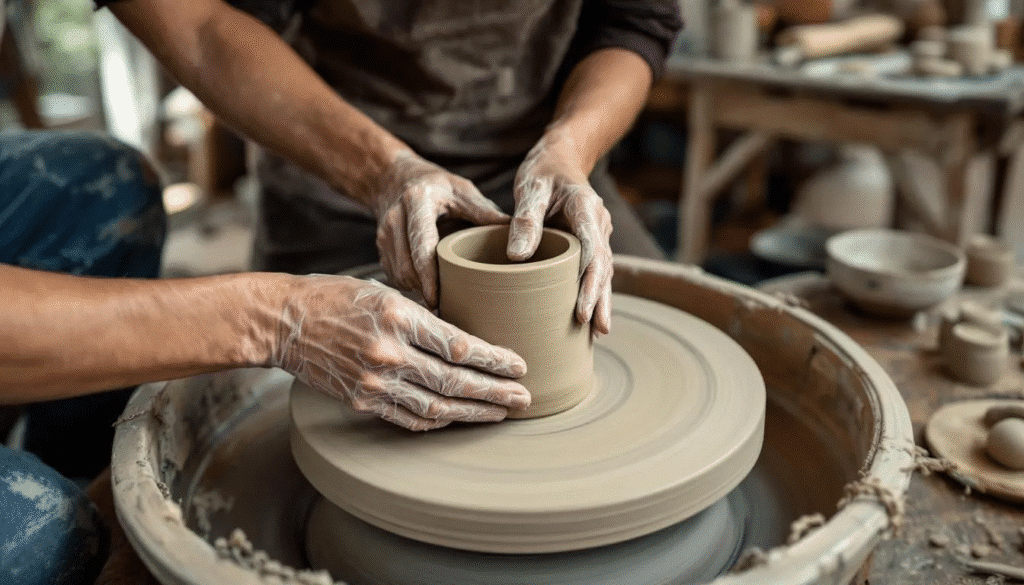
Benefits of 3D Crafting
Research consistently demonstrates that three-dimensional crafting provides significant mental health benefits. The tactile engagement and focused concentration required for these projects naturally reduce anxiety and lower cortisol levels, making crafting an effective stress management tool for busy adults.
Beyond stress relief, dimensional crafting enhances cognitive function through multi-step processes that improve spatial reasoning, hand-eye coordination, and problem-solving skills. The satisfaction of completing a complex project boosts self-esteem and provides a tangible sense of accomplishment that’s often missing from daily work routines.
Studies show that over 40% of surveyed adults participate in some form of crafting, with dimensional crafts growing at approximately 8% annually since 2021. This growth reflects adults’ increasing desire for hands-on creative activities that produce lasting, displayable results. Among these, 3D puzzles serve as a canvas for creative expression and artistic innovation, offering both entertainment and a sense of accomplishment.
Essential Tools and Materials
Getting started with 3D crafts requires specific tools tailored to your chosen medium. For paper crafts, essential supplies include precision scissors, craft knives, scoring tools, and various adhesives like PVA glue and double-sided tape. Many crafters find cutting machines invaluable for intricate patterns and consistent results.
Clay work demands sculpting tools, rolling pins, moisture sprays, and protective equipment including plastic gloves and aprons. Good quality tools make a significant difference in both the crafting process and final results, though many household items can serve as effective alternatives when starting out.
For mixed media projects, you’ll need spatulas, paintbrushes, wire cutters, and appropriate sealants. The beauty of mixed media lies in its flexibility – supplies can often be found around the house or sourced from recycling materials.
Budget-conscious beginners can start with basic starter kits ranging from $20-30, available at major craft retailers. These typically include fundamental materials and simple instructions to help you explore different techniques before investing in specialized equipment. Using simple materials, adults can also create beautiful 3D decorations for home decor, making crafting accessible and rewarding for everyone.
How 3D Crafts Differ from Traditional Flat Crafts
Three-dimensional crafts engage viewers from multiple angles, creating opportunities for dramatic light and shadow play that flat crafts simply cannot achieve. This multi-perspective nature makes 3D pieces particularly effective as home décor, creating focal points that draw attention and spark conversation.
The spatial planning required for dimensional work develops different cognitive skills than flat crafting, challenging creators to think architecturally about structure, balance, and visual flow. This complexity often makes the creative process more engaging and the finished results more satisfying.
Current trends in 2024 emphasize technology integration, with laser-cut kits and cutting machines making complex projects more accessible. Sustainability consciousness drives interest in upcycling cardboard, fabric scraps, and other household materials. Meanwhile, hybrid art forms combining traditional techniques with modern elements like LED lights create striking contemporary pieces perfect for modern homes.
3D Paper Crafts for Advanced Creators
Paper crafting has evolved into a sophisticated art form that challenges traditional notions of what’s possible with this humble material. Advanced paper crafts demand precision, patience, and spatial thinking, but reward crafters with stunning sculptural pieces that rival more expensive art forms. For inspiration and resources, explore the art of paper crafting at Simply Paper Crafts.
Geometric Paper Sculptures
Creating geometric paper sculptures requires heavy cardstock and meticulous cutting techniques. Modern creators often use digital templates and cutting machines for accuracy, though hand-cutting remains a meditative option for those who enjoy the complete process. Assembly methods typically involve tabs and slots, strategic gluing, and careful stacking to achieve complex polyhedra, faceted animals, and abstract forms.
The key to success lies in precise scoring – creating clean fold lines that allow crisp edges and smooth curves. Many crafters use bone folders or scoring tools to ensure professional-looking results. Templates are widely available online, or you can create your own designs using geometric principles and paper engineering software.
These sculptures make impressive wall art or table displays, particularly when created in coordinating colors or metallic papers that catch and reflect light throughout the day.
Layered Shadow Boxes
Shadow boxes represent one of the most rewarding paper crafts, creating miniature worlds within frames. These projects consist of multiple paper layers assembled with foam tape for spacing, building depth that creates the illusion of three-dimensional landscapes or cityscapes.
Popular themes include nature scenes with layered mountains and forests, urban skylines with building silhouettes, or seasonal displays perfect for christmas decorating. The technique works beautifully with multi-colored papers, and many crafters incorporate metallic or textured papers for dramatic visual effects.
The process begins with sketching your design and determining layer placement. Working from background to foreground, each layer adds detail and depth. Proper spacing between layers is crucial – too little creates a flat appearance, while too much can make the piece appear disconnected.

Kirigami and Pop-up Card Making
Kirigami, combining cutting and folding techniques, enables creation of intricate pop-up sculptures and cards that amaze recipients. This Japanese art form requires precise template work and careful attention to fold lines, but produces remarkable three-dimensional results from flat paper.
Advanced kirigami projects include architectural models, organic flower forms, and complex geometric patterns. The key lies in understanding how cuts and folds interact – where to score for valley folds versus mountain folds, and how cutting patterns affect the final dimensional form.
Pop-up card mechanisms introduce engineering principles, using cam systems, levers, and pivoting elements to create moving, interactive displays. These make particularly meaningful gifts, as the surprise element adds emotional impact to the artistic achievement.
Paper Quilling Sculptures
Quilling transforms thin paper quilling strips into realistic three-dimensional objects through curling, shaping, and strategic gluing. Advanced adult projects move beyond simple flower shapes to create lifelike insects, elaborate decorative panels, and complex sculptural forms.
Three-dimensional quilling adds stacking and layering techniques that create remarkable realism. Crafters can achieve texture variations by varying strip widths, using different paper weights, and incorporating multiple colors within single elements. The technique works beautifully when integrated with shadow boxes or used to create standalone sculptural pieces.
Modern quilling artists often combine traditional techniques with contemporary design sensibilities, creating pieces that feel both timeless and current. The meditative nature of rolling individual coils makes this an excellent stress-relief activity that produces stunning results.
Book Folding Art
Transforming old novels into sculpture represents both artistic expression and environmental consciousness. This technique involves folding pages in carefully planned sequences to create words, silhouettes, or geometric shapes that emerge from the book’s edge.
The process requires patience and mathematical planning – measuring page dimensions, calculating fold positions, and maintaining consistent spacing throughout hundreds of pages. However, the results create striking displays that honor both literary and visual art traditions.
Book folding art makes excellent gifts for literature lovers and provides a sustainable way to repurpose books that might otherwise be discarded. The technique works particularly well with hardcover books that provide structural stability for complex designs.
Clay and Polymer 3D Sculpting Projects
Clay sculpting offers unparalleled versatility for adults seeking hands-on creative expression. Whether working with air-dry, polymer, or self-hardening varieties, clay provides immediate tactile satisfaction while developing skills that transfer to many other craft forms.
Air-dry Clay Miniatures
Creating miniature food collections has become increasingly popular among adult crafters, with realistic sushi, pastries, and fruit sculptures leading the trend. Air-dry clay excels for this application since it requires no special equipment – simply air drying over 24-48 hours depending on thickness.
The key to realistic miniatures lies in observation and layering techniques. Study real food items closely, noting color variations, textures, and proportions. Build pieces gradually, allowing each layer to partially dry before adding details. Household items like toothpicks, combs, and sponges create authentic textures for everything from bread crusts to citrus peels.
These miniatures serve multiple purposes – from dollhouse accessories to unique home décor elements. Many crafters create entire themed collections, such as a complete sushi bar or French patisserie display.
Polymer Clay Jewelry and Pendants
Polymer clay jewelry offers endless creative possibilities, from simple geometric pendants to elaborate statement pieces incorporating multiple techniques. Brands like Sculpey and Fimo provide consistent results when baked in household ovens, making this accessible for most home crafters.
Advanced techniques include color blending for gradient effects, texturing with stamps or household items, and surface treatments using mica powders or metallic paints. Cane-making and millefiori patterns add complexity and professional appearance to finished pieces.
The baking process requires attention to temperature and timing – most polymer clays bake at 130°C (265°F) for 15-30 minutes per 6mm thickness. Proper conditioning before sculpting prevents cracking, while post-baking finishing with fine sandpaper and varnish creates professional-quality results.

Fantasy Creature Sculptures
Sculpting mythological creatures like dragons and unicorns allows imagination to guide the creative process while developing advanced modeling skills. These projects often require wire armatures for structural support, particularly for pieces with extended limbs or wings.
Building successful fantasy sculptures starts with planning the pose and overall composition. Create a simple wire frame that establishes major body segments and limb positions, then build up forms gradually with clay layers. This approach prevents structural failures and allows for adjustments during the sculpting process.
Surface texturing brings fantasy creatures to life – use various tools to create scales, fur, feathers, or magical elements. Many crafters finish these pieces with acrylic paints and protective sealers, creating display-worthy sculptures that capture their imaginative visions.
Functional Clay Items
Creating functional items like bowls, planters, and trinket dishes combines artistic expression with practical utility. These projects require consideration of both aesthetics and functionality – adequate thickness for durability, smooth surfaces for cleaning, and appropriate sizing for intended use.
Self-hardening clay works well for decorative functional pieces, though items intended for food contact require food-safe finishing materials. The sculpting process often involves hand-building techniques like coiling or slab construction rather than wheel throwing.
Surface treatments can dramatically affect both appearance and functionality. Sanding creates smooth surfaces, while strategic texturing adds visual interest and improves grip. Sealing with appropriate finishes ensures water resistance and durability for long-term use.
Essential Clay Working Techniques
Proper clay conditioning forms the foundation of successful sculpting. Knead clay thoroughly to achieve consistent texture and eliminate air bubbles that could cause cracking during drying. Maintain appropriate moisture levels throughout the working session using spray bottles or damp cloths.
Rolling clay to consistent thickness (typically 5mm for wall pieces) creates stability and even drying. Use rolling guides or dedicated clay rollers for best results. When working on extended projects, cover work-in-progress with plastic to prevent premature drying.
Tool selection impacts both process and results. Dedicated sculpting tool sets provide optimal functionality, but many household items work effectively – butter knives for cutting, spoons for smoothing, and various textured items for surface effects. Experiment with different tools to discover unique texturing possibilities.
Repair techniques prove essential for complex projects. Cracks can often be repaired by adding moisture and gently working clay fibers together. For polymer clay, incomplete curing may allow repairs by adding fresh clay and re-baking.
Finishing transforms raw clay pieces into polished artworks. Sand surfaces progressively with fine grits, apply base colors with acrylic paints, and seal with appropriate varnishes or resins. Each step builds toward professional-quality results that justify the time invested in creation.
3D String Art and Fiber Crafts
String and fiber crafts offer unique textural possibilities that create striking dimensional effects through careful manipulation of flexible materials. These techniques range from precise geometric patterns to organic, flowing forms that soften any space.
Modern String Art Patterns
Contemporary string art has evolved far beyond simple nail-and-string patterns, incorporating colored threads, embroidery floss, and complex layering techniques. Modern patterns include geometric mandalas, nature scenes, and abstract compositions that create dynamic visual movement through careful tension control.
The foundation begins with pattern transfer to a backing board, typically using templates printed on paper and transferred with nail placement guides. Quality matters in string selection – embroidery floss provides vibrant colors and smooth texture, while heavier yarns create bold, dramatic effects.
Layering multiple colors adds depth and complexity to finished pieces. Start with background elements in neutral tones, then build up focal points with brighter colors. The interplay between string tensions creates natural curves and organic shapes that would be difficult to achieve with rigid materials.
Macrame Wall Hangings
Macrame combines traditional knotting techniques with contemporary design sensibilities to create dimensional wall art that adds both texture and visual interest to living spaces. Modern macrame incorporates diverse cord types, mixed textures, and additional elements like beads or wooden rings.
Basic knots – square knots, half hitches, and lark’s head knots – combine to create complex patterns and varying textures. The dimensional aspect comes from varying cord lengths, creating fringe elements, and incorporating three-dimensional forms like spirals or geometric shapes.
Advanced techniques include incorporating different fiber types within single pieces, creating color gradients through cord selection, and adding structural elements like driftwood or metal rings that enhance both stability and visual appeal.
Needle Felting Sculptures
Needle felting transforms wool roving into dense, sculptural forms through repeated stabbing with specialized barbed needles. This technique allows creation of realistic animals, whimsical characters, and abstract forms with remarkable detail and lifelike textures.
The process begins with core shaping using coarse wool, gradually adding finer details and surface textures with progressively finer wool varieties. Color blending occurs naturally as different wool colors integrate during the felting process, creating subtle gradations that enhance realism.
Advanced needle felting incorporates armature techniques for larger pieces, mixed fiber types for texture variation, and surface treatments that create specific effects like fur patterns or facial features. The technique works particularly well for creating unique gifts or decorative elements that add warmth and personality to any room.
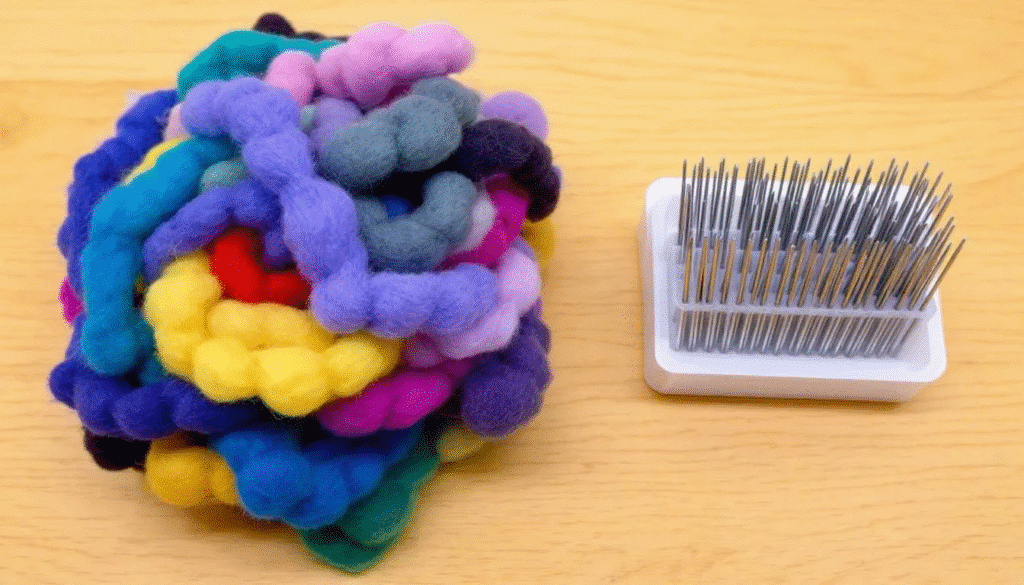
3D Embroidery Techniques
Three-dimensional embroidery, including stumpwork techniques, lifts design elements off fabric surfaces to create remarkable dimensional effects. These advanced techniques use wire supports, padded stitches, and layering to achieve realistic flowers, insects, and landscape elements.
The dimensional aspect comes from strategic use of padding materials, wire armatures for structural support, and stitching techniques that build up surface texture. Many practitioners combine traditional embroidery stitches with contemporary materials and design approaches.
Surface variations create visual interest through contrasting textures – smooth satin stitches adjacent to heavily textured French knots, or raised chain stitches that create linear dimensional elements. The interplay between flat and dimensional areas creates sophisticated compositions that reward close examination.
Wire and Yarn Combinations
Combining wire armatures with yarn coverings creates sculptures that balance structural stability with soft, appealing textures. This hybrid technique allows creation of free-standing figures, architectural forms, and abstract sculptures that would be impossible with either material alone.
The wire provides structural integrity and allows positioning adjustments throughout the wrapping process. Yarn selection affects both appearance and working characteristics – smooth yarns create clean lines, while textured varieties add visual interest and hide minor inconsistencies in wrapping technique.
Color planning becomes crucial in wire and yarn pieces, as changing yarns mid-project requires careful planning and technical skill. Many crafters plan color transitions to coincide with natural breaking points in the armature design, creating seamless visual flow throughout the finished piece.
Wooden 3D Puzzle and Construction Kits
Wooden construction kits offer the satisfaction of engineering and craftsmanship without requiring extensive woodworking skills. These projects combine precise laser-cut components with detailed assembly instructions, resulting in impressive mechanical or architectural models. DIY craft kits provide all necessary materials and instructions for creating crafts, making them an excellent choice for beginners and experienced crafters alike.
Mechanical Wooden Puzzles and Marble Runs
Laser-cut wooden puzzle kits featuring interlocking gears and marble pathways create interactive décor that fascinates viewers of all ages. These sophisticated engineering projects typically require 4-8 hours of focused assembly time, making them perfect for extended crafting sessions.
The assembly process itself becomes meditative, requiring attention to detail and logical problem-solving. Each component fits precisely with others, and the gradual revelation of the mechanism’s function provides ongoing satisfaction throughout the build process.
Quality kits include detailed instructions with clear diagrams, though the assembly process rewards careful examination of components and patient trial-and-error fitting. Many completed pieces function as kinetic sculptures, with moving parts that demonstrate mechanical principles while serving as conversation pieces.
Architectural Model Kits
Recreating famous landmarks and buildings through wooden model kits develops spatial reasoning skills while creating impressive display pieces. These projects range from simple structures suitable for beginners to complex architectural marvels requiring advanced assembly skills.
Build times vary significantly based on complexity – simple models might be completed in a single afternoon, while elaborate structures like gothic cathedrals or modern skyscrapers can require multiple sessions over several weeks. The extended timeline allows crafters to work at their own pace while building skills progressively.
Many architectural kits include historical information about the original structures, adding educational value to the crafting experience. This combination of hands-on building and learning appeals to adults who appreciate both engineering challenges and cultural knowledge.
Steampunk-Inspired Clockwork Puzzles
Functional clockwork mechanisms appeal to engineering-minded adults who appreciate both aesthetic design and mechanical function. These kits often include working clock movements, gear trains, and automata elements that create moving displays.
The steampunk aesthetic combines Victorian-era mechanical design with contemporary precision manufacturing, resulting in pieces that function as both timekeepers and sculptural art. Assembly requires careful attention to gear alignment and timing, developing mechanical understanding through hands-on experience.
Advanced kits may include features like chiming mechanisms, multiple moving elements, or complex gear ratios that demonstrate mechanical principles. These pieces often become cherished heirlooms that combine functional utility with artistic expression.
Quality and Sourcing Considerations
Quality laser-cut wooden kits typically cost between $30-50 for standard complexity projects, with premium or large-scale models reaching $100 or more. The investment reflects precision manufacturing and comprehensive instruction materials that ensure successful completion.
Budget-conscious crafters can find quality options through online retailers and specialty hobby shops, particularly during seasonal sales. Many suppliers offer beginner-friendly starter kits that provide introduction to wooden construction techniques without major financial commitment.
Component quality varies significantly between manufacturers. Look for kits with smooth, precisely cut edges, clear grain patterns, and comprehensive instruction materials. Customer reviews often provide valuable insights into assembly difficulty and final result quality.
Mixed Media 3D Art Projects
Mixed media approaches combine diverse materials and techniques to create unique dimensional artworks that transcend traditional craft categories. This experimental approach encourages creativity while developing technical skills across multiple mediums.
Resin Art with Embedded Objects
Transparent resin creates stunning effects when combined with embedded elements like shells, dried flowers, or decorative papers. These projects require careful attention to safety protocols, including adequate ventilation and protective equipment, but produce remarkable results that capture and preserve three-dimensional compositions.
The layering process allows creation of complex scenes – ocean effects with embedded shells and blue pigments, galaxy scenes with metallic powders and glitter, or natural compositions incorporating pressed flowers and leaves. Each layer must cure completely before adding subsequent elements, extending project timelines but ensuring professional results.
Timing becomes critical in resin work, as working time varies with temperature and humidity. Many crafters prepare all elements in advance and work efficiently during the limited working window. Practice with small projects builds confidence before attempting larger, more complex compositions.
Upcycled Material Sculptures
Environmental consciousness drives interest in creating impressive sculptures from discarded materials. Cardboard, fabric scraps, plastic bottles, and other household recyclables can be transformed into sophisticated artworks through creative vision and skillful assembly.
The challenge lies in visualizing potential within mundane materials and developing techniques that ensure structural integrity and attractive finishing. Many successful upcycled projects combine multiple materials strategically – cardboard for structure, fabric for surface treatment, and wire for flexible connections.
Surface treatments often make the difference between amateur and professional-looking results. Paint, fabric coverings, and strategic lighting can completely transform humble materials into striking artistic statements that rival traditionally crafted pieces.
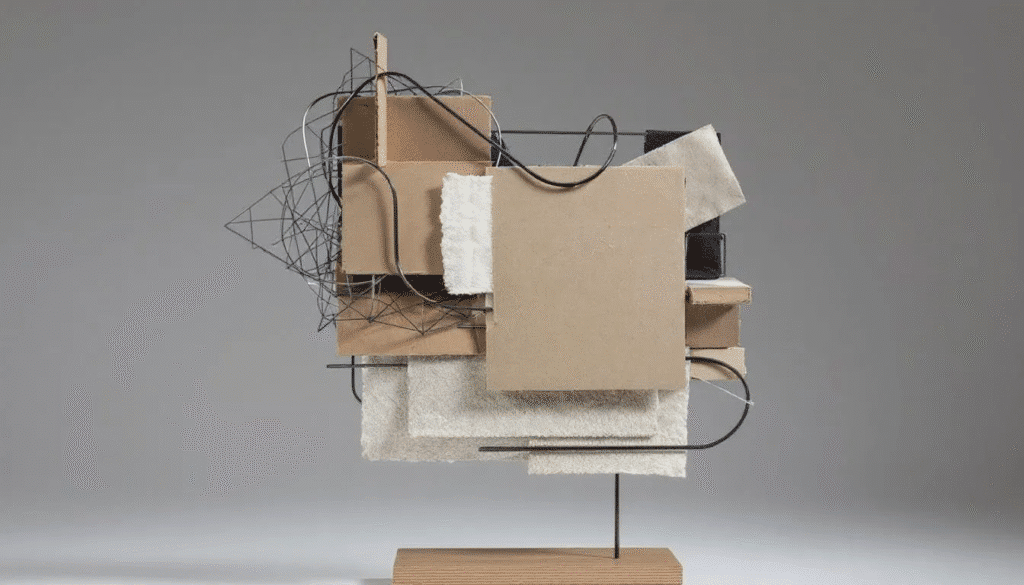
Wire Armature Figures
Wire armatures provide structural foundations for figures that can be developed with various covering materials including fabric, clay, or found objects. This technique allows creation of dynamic poses and complex forms that would be difficult to achieve with single-material approaches.
The wire selection affects both workability and final strength. Aluminum wire offers easy manipulation but limited strength, while steel wire provides durability but requires more effort to shape. Many crafters use different wire gauges within single projects – heavy wire for major structural elements and lighter gauges for detail work.
Covering techniques vary based on desired effects and material choices. Fabric wrapping creates soft, organic appearances, while clay applications allow detailed surface modeling. The combination of rigid armature and flexible covering materials enables both structural stability and surface refinement.
LED-Integrated Crafts
Embedding LED lighting within dimensional artworks creates dramatic illuminated effects that transform pieces into interactive displays. Battery-powered LED strips and individual lights make this technology accessible for craft applications without requiring electrical expertise.
Planning light placement during initial design phases ensures optimal effects and concealed wiring. Many successful projects incorporate translucent materials like resin or fabric that diffuse light attractively while hiding technical elements. Color-changing LEDs add dynamic elements that maintain viewer interest over time.
Safety considerations include using low-voltage systems appropriate for craft applications and ensuring adequate heat dissipation for enclosed lighting elements. Many crafters begin with simple single-color applications before progressing to complex programmable lighting systems.
Advanced 3D Origami and Kirigami
Advanced paper folding techniques create sophisticated sculptural forms that challenge traditional notions of origami’s limitations. These projects require patience, precision, and spatial reasoning but reward practitioners with stunning origami designs, including geometric and organic forms.
Modular Origami Geometric Forms
Complex geometric models constructed from multiple folded units showcase mathematical principles while creating striking visual displays. Some advanced models incorporate hundreds of individual modules, each precisely folded and assembled without adhesives into stable, three-dimensional forms.
The assembly process requires systematic approach and careful attention to unit orientation. Many practitioners work in stages, completing groups of modules before final assembly. This approach prevents overwhelming complexity while building confidence through progressive achievement.
Color planning becomes crucial in modular origami, as color patterns affect both visual impact and assembly guidance. Strategic color placement can emphasize geometric relationships or create gradient effects that enhance dimensional perception.
Wet-Folding Techniques
Moistening paper before folding enables creation of smooth, sculptural curves impossible with dry-folding methods. This advanced technique produces organic forms including realistic animals, flowing abstract shapes, and architectural elements with natural-looking curves.
Paper selection affects wet-folding success significantly. Heavy papers with good wet strength maintain structural integrity during folding, while lighter papers may tear or become unworkable when moistened. Experimentation with different paper types helps identify optimal materials for specific projects.
Timing requires careful attention as paper moisture content affects foldability throughout the working process. Too much moisture weakens paper structure, while insufficient moisture prevents smooth curve formation. Many practitioners develop intuitive feel for optimal working conditions through practice.
Pop-up Engineering Principles
Creating sophisticated pop-up mechanisms requires understanding of basic engineering principles including leverage, pivot points, and mechanical advantage. These concepts translate into paper mechanisms that create dramatic three-dimensional transformations from flat starting positions.
Advanced pop-up designs incorporate multiple moving elements, sequential actions, and complex linkages that create elaborate kinetic displays. Many contemporary pop-up artists use computer-aided design tools to plan mechanism geometry before cutting and assembly.
Testing and refinement form essential parts of pop-up development, as minor adjustments to pivot placement or link lengths can dramatically affect mechanism function. Prototype development using inexpensive materials allows experimentation without risking final project materials.
Getting Started: Tools and Workspace Setup
Successful 3D crafting depends heavily on having appropriate tools and workspace organization. While elaborate setups aren’t necessary for beginners, thoughtful tool selection and workspace planning significantly improve both process enjoyment and result quality.
Essential Cutting Tools
Precision cutting forms the foundation of most dimensional crafts, making quality cutting tools essential investments. Craft knives with replaceable blades provide clean, accurate cuts for detail work, while quality scissors handle broader cutting tasks efficiently.
Rotary cutters excel for fabric and paper crafts where long, straight cuts are required. The rolling action creates smoother cuts than scissors while reducing hand fatigue during extended cutting sessions. Cutting mats protect work surfaces while providing measuring guides and self-healing surfaces that extend blade life.
Tool maintenance affects both performance and safety. Sharp blades require less pressure and produce cleaner cuts, while dull blades can slip unexpectedly and damage both projects and crafters. Regular blade replacement and proper storage extend tool life while maintaining consistent performance.
Adhesive Selection Guide
Different projects require specific adhesives for optimal results and longevity. PVA glue provides strong bonds for porous materials like paper and fabric, while hot glue offers quick setting for mixed-material assemblies. Epoxy adhesives create high-strength bonds for structural applications requiring permanent assembly.
Double-sided tape offers clean, precise adhesion for layered paper projects where visible glue lines would detract from finished appearance. Foam tape creates dimensional spacing for shadow box effects while providing strong adhesive bonds.
Application techniques affect adhesive performance significantly. Thin, even coats prevent squeeze-out and maintain clean appearance, while adequate coverage ensures strong bonds. Working time varies between adhesive types, requiring planning for complex assemblies with multiple components.
Workspace Organization for Small Spaces
Efficient workspace organization becomes crucial for apartment dwellers and those with limited dedicated craft space. Vertical storage maximizes material accessibility while minimizing footprint, using wall-mounted organizers and stackable containers to create functional work areas in compact spaces.
Portable organization systems allow quick setup and breakdown for shared spaces. Rolling carts, collapsible tables, and modular storage systems enable serious crafting without permanent space dedication. Many crafters develop systems that pack completely into closets or under beds when not in use.
Lighting quality affects both work comfort and result precision. Adjustable LED lights provide bright, even illumination while generating minimal heat. Task lighting focused on work areas supplements general room lighting for detailed projects requiring close examination.
Safety Equipment and Practices
Personal protective equipment prevents injuries while enabling confident tool use. Cut-resistant gloves protect hands during knife work, while safety glasses shield eyes from flying debris during cutting or drilling operations. These investments in safety enable more ambitious projects by reducing injury risks.
Ventilation becomes critical when working with adhesives, paints, or resin systems that produce potentially harmful vapors. Fans, open windows, or dedicated ventilation systems ensure adequate air circulation for health protection during extended crafting sessions.
First aid preparation includes having appropriate supplies readily available and understanding basic treatment for common crafting injuries. Knowing how to treat cuts, burns, and eye irritation enables quick response that minimizes injury severity and recovery time.
Budget-Friendly Starter Approaches
Beginning crafters can start with minimal investment while exploring different techniques and discovering personal preferences. Basic starter kits ranging from $20-30 provide sufficient materials for initial project completion while allowing technique exploration without major financial commitment.
Household items often substitute effectively for specialized tools during initial learning phases. Butter knives work for clay sculpting, rulers substitute for metal straightedges, and various containers provide paint mixing and water storage. This approach allows skill development before investing in specialized equipment.
Progressive tool acquisition allows budget spreading while building collections based on actual usage patterns rather than theoretical needs. Starting with essential tools and adding specialized items based on project requirements creates efficient, personalized tool collections without unnecessary expense.
Displaying and Preserving Your 3D Crafts
Creating beautiful dimensional artwork represents only half the crafting journey – proper display and preservation ensure your creations remain stunning for years while enhancing your living space or creating meaningful gifts for family and friends.
Photography Techniques for Dimensional Art
Capturing three-dimensional artwork requires different approaches than flat photography, emphasizing the sculptural qualities that make these pieces special. Indirect lighting prevents harsh shadows while revealing surface textures and dimensional details that direct flash photography would flatten.
Multiple angle photography showcases the dimensional nature that distinguishes 3D crafts from flat art forms. Include shots from various viewpoints, close-ups highlighting texture details, and images showing scale relationships with familiar objects. This comprehensive documentation serves both personal records and sharing purposes.
Background selection significantly affects image quality and viewer focus. Neutral backgrounds eliminate distractions while allowing artwork to dominate the visual space. Consider how background colors interact with your piece’s colors – complementary backgrounds enhance visual impact while clashing colors detract from artistic achievement.
Protective Display Solutions
Delicate three-dimensional pieces benefit from protective display cases that shield them from dust, handling damage, and environmental factors while maintaining visibility. Glass or acrylic cases provide complete protection while allowing 360-degree viewing of sculptural elements.
Adjustable display stands accommodate various sizes and shapes while providing stable support for dimensional pieces. Museum-quality mounting systems distribute weight evenly and allow position adjustments without handling delicate artwork directly.
Custom display solutions often work best for unique pieces or collections. Building simple display boxes, creating wall-mounted shadow boxes, or designing integrated display furniture allows personalized presentation while protecting valuable handmade items.
Long-term Preservation Strategies
UV protection prevents fading and material degradation that can destroy years of creative work. UV-resistant sprays provide invisible protection for exposed pieces, while UV-filtering glass or acrylic covers protect display-cased items from harmful light exposure.
Climate control affects material stability over time. Extreme temperature or humidity fluctuations can cause expansion, contraction, or chemical changes that damage delicate crafts. Stable indoor environments provide optimal preservation conditions for most craft materials.
Documentation creates permanent records of your creative achievements while providing insurance and gift information. Photograph pieces immediately after completion, maintain creation date records, and note special techniques or materials used. This documentation becomes increasingly valuable as skills develop and pieces appreciate in personal and monetary value.
Creating Dedicated Display Spaces
Thoughtful display integration enhances both artwork and living spaces by creating focal points that reflect personal creativity and style. Consider how dimensional pieces interact with existing décor, lighting conditions, and traffic patterns throughout your house.
Rotating displays keep living spaces fresh while providing opportunities to showcase different pieces seasonally or based on mood changes. This approach also provides protective storage for pieces not currently displayed while maintaining variety in home décor.
Themed groupings create visual impact that exceeds individual piece presentation. Collecting similar techniques, color palettes, or subject matters into cohesive displays creates sophisticated presentations that demonstrate artistic development over time.
Gifting and Packaging Handmade Art
Handmade dimensional artwork makes uniquely meaningful gifts that demonstrate time, thought, and personal connection impossible with purchased items. However, proper packaging ensures safe delivery while enhancing presentation and recipient appreciation. 3D crafting is a rewarding activity that can lead to the creation of beautiful handmade gifts, adding a personal touch that recipients will cherish.
Protective packaging prevents damage during transport while building anticipation through thoughtful presentation. Custom boxes, tissue paper wrapping, and protective materials show respect for both artwork and recipient while ensuring safe arrival.
Documentation enhances gift value by providing creation stories, technique explanations, and care instructions. Include cards describing inspiration, special materials used, or time invested in creation. This information transforms handmade gifts into treasured keepsakes with personal significance.
Creating presentation materials like artist statements or technique descriptions adds professional polish while educating recipients about craft processes and artistic decisions. This documentation increases appreciation for the skill and creativity represented in handmade gifts.
Conclusion
The world of 3D crafts for adults offers endless opportunities to explore creativity, develop new skills, and create stunning dimensional artwork that enhances both personal well-being and living spaces. From the meditative rhythm of clay sculpting to the precise engineering of paper mechanisms, these hands-on activities provide perfect balance to our increasingly digital lives.
Whether you’re drawn to the geometric precision of modular origami, the tactile satisfaction of needle felting, or the experimental nature of mixed media assemblages, dimensional crafting offers something for every creative spirit. The key lies in starting with projects that match your current skill level while gradually building confidence and technique through practice and experimentation.
Remember that every expert crafter began as a beginner, and each completed project builds skills that transfer to future creative endeavors. Start with simple techniques using basic supplies, and allow your skills and interests to guide you toward more complex and personally meaningful projects.
The therapeutic benefits of hands-on creativity, combined with the satisfaction of creating lasting, beautiful objects, make 3D crafts an investment in both personal well-being and artistic development. As you begin this creative journey, remember that the process itself provides as much value as the finished results – enjoy each step, learn from challenges, and celebrate the unique artistic voice that emerges through your dimensional creations.
Your imagination is the only limit in the expansive world of three-dimensional crafting. Take that first step, gather your supplies, and discover the joy of creating art you can hold, admire from every angle, and proudly display as testament to your creative spirit.

